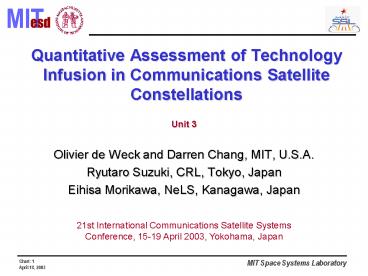Quantitative Assessment of Technology Infusion in Communications Satellite Constellations - PowerPoint PPT Presentation
Title:
Quantitative Assessment of Technology Infusion in Communications Satellite Constellations
Description:
Quantitative Assessment of Technology Infusion in Communications Satellite Constellations Unit 3 Olivier de Weck and Darren Chang, MIT, U.S.A. Ryutaro Suzuki, CRL ... – PowerPoint PPT presentation
Number of Views:104
Avg rating:3.0/5.0
Title: Quantitative Assessment of Technology Infusion in Communications Satellite Constellations
1
Quantitative Assessment of TechnologyInfusion in
Communications SatelliteConstellations
Unit 3
- Olivier de Weck and Darren Chang, MIT, U.S.A.
- Ryutaro Suzuki, CRL, Tokyo, Japan
- Eihisa Morikawa, NeLS, Kanagawa, Japan
21st International Communications Satellite
Systems Conference, 15-19 April 2003, Yokohama,
Japan
2
Outline
- Introduction and Motivation
- Previous Work in Technology Assessment
- Quantitative Technology Infusion Assessment
Methodology - Application to Satellite Communications
Constellations - Conclusions
- Future Work
3
Motivation
- The architecture of satellite communications
systems (concept) must be carefully selected - Selection of architectures can be done
quantitatively based on performance, cost and
capacity predictions see AIAA-2002-1866 - A number of new technologies are currently under
development for GEO and LEO Systems, e.g. - Large Deployable Reflector (LDR) Antennas
- Optical Inter-satellite Links (OISL)
- System Designers/Architects must often choose
between competing technologies need a
quantitative method - Generally, better understand the relationship
between architectures and technologies
4
Conceptual Design Space
Can we quantify the conceptual system design
problem using simulation and optimization?
5
Key Idea Pareto Impact
6
Previous Work
- Metrics for comsat architecture evaluation cost
per function CPF /min at a fixed data
rate R, BER pb and link margin (Hastings, Shaw.) - Architecture Evaluation and Selection using MDO
(multi-disciplinary design optimization)
Miller, Jilla, de Weck - Research in new generations of satellite
constellations (e.g. NeLs, R. Suzuki) and new
technologies - Technology assessment proposed by Management of
Technology (MOT) Utterback, van Wyk, Henderson
and Clark - Technology Selection Mavris, DeLaurentis
gt Perceive a missing link between architecture
evaluation and technology selection
7
Assumptions
- Possible to create high-fidelity simulations of
satellite communications systems during
conceptual design - Performance per channel is fixed
- Data Rate
- Bit-Error-Rate
- Link Fading Margin
- Tradeoff between system capacity and lifecycle
cost - Architectures are realizable with existing,
mature technologies
8
Proposed Methodology
9
Steps 1-3
Step 1 Baseline Trade Space Exploration -
Obtain Baseline Pareto Frontier Po
Step 2 Technology Identification,
Classification, Modeling - Understand
technology dependencies Tc, Td - Technology
modeling physics based, prototype data,
empirical relationships (expert interviews)
Step 3 Technology Infusion Interface Development
10
Steps 4-6
Step 4 Individual Technology Assessment
Step 5 Assessment of allowable combinations
of technologies Step 6 Comparison
and Interpretation - based on Pareto Impact
Metrics (4)
11
Application LEO Com Sat
LEO Constellation 50 satellites 5 planes h800 km
12
Benchmarking
- Benchmarking validating a simulation
- by comparing the predicted response against
reality.
13
Design Trade Space
Design Vector
1728 Full Factorial Combinatorial Design Space
14
Baseline Case
Baseline Design Space Uses only Existing,
Mature Technologies
Channel Perf
R4.8 kbps pb0.001 LM16 dB
15
Technology Portfolio
Technology Dependency Matrix
T1 T2 T3 T4
T1 0 1 0 0
T2 0 0 0 0
T3 0 0 0 0
T4 0 0 1 0
T1 Optical Inter-Satellite Links (OISL) T2
Asynchronous Transfer Mode (ATM) T3 Large
Deployable Reflectors (LDR) T4 Digital/Analog
Beamforming (DBF)
Techno Description Satellite () (-)
OISL Replace RF ISL Spot-4 Rgt10Gbps Pointing requirement
ATM Packet/circuit switching ACTS Efficiency Mass penalty
LDR DA up to 20m ETS-VIII Gain 38-45 dBi Large Stowage Volume
DBF Ground fixed cells TBD Handover Complexity
16
Example Impact of LDR
Large Deployable Reflectors (LDR)
ETS-VIII
E.g. for DA6m -gt GT39 dBi, l0.19m,
TFU2.45 M
17
Pareto Impact Example LDR
Po is the normalized Pareto front with baseline
technologies alone.
P3 is the normalized Pareto front with LDR.
Decreased utopia point distance
18
Overview Results - MP
19
Conclusions
- Presented a methodology for quantitatively
assessing technology impact on Communication
Satellites - Choose between mature, existing technologies
versus newly emerging, competing technologies - Technology portfolio technology investment
decisions - Use simulation to predict performance, cost and
capacity for a set of candidate architectures - Careful benchmarking required
- Modular simulation architecture eases
investigation of a large set of technologies - Current technologies under development for NeLS
make sense for broadband, multimedia system - Engineering Systems Industry Study will be
available
20
Future Work
- Harden and verify this methodology by deploying
in an industrial/satellite manufacturer setting,
apply to GEO - Uncertainty in effect on Pareto front P due to
technology maturity e.g. measured via NASAs
Technology Readiness Levels (TRL) probabilistic - Expand work to more than two (2) objectives
- How to deal with disruptive technologies that
enable new architectures in that case dont
have a baseline Pareto front to compare to, e.g.
introduction of ISL when only bent-pipe was
known. - Understand relationship between Pareto Impact
metrics and technology obsolescence































